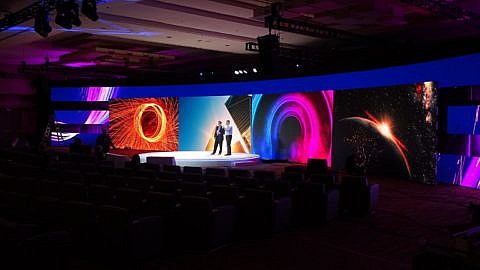Whether you are an experienced presenter or preparing to present in front of an audience for the first time, our Centrifuge Media performance development team exists to bring out the best in your presentation.
Through our experience working with countless presenters at every level of public speaking comfort, we have assembled a list of 8 foundational guidelines that will allow you to work a room and audience of any size.
Presenter’s Guideline 1: Know your Content
Though it may seem obvious, spending the appropriate time with the content that you are about to deliver is critical to the success of your presentation. We know, it’s not as simple as it sounds. Often, our clients receive data and information shortly before the presentation is to take place. This can make the idea of adequate preparation seem daunting if not impossible. However, there is a way to approach the flow of your presentation that will provide you with maximum agility and ease of preparation, even during the tightest time crunch.
Consider the speech you are about to deliver from the audience’s perspective. If you think of yourself as an audience member, try to imagine what it is that will keep your attention and assist in your interest and ability to retain information.
Presenter’s Guideline 2: There’s a Story to Everything
When our clients are coached to shift from presenting to storytelling, they are less taxed with the idea of remembering heavy data and details, and better able to plan for moments of audience engagement and open conversation. This approach provides an improved flow of information and appeals to the area of the brain that allows for message retention. It becomes a win-win for the audience and the presenter.
Does this mean that you have to abandon your data presentation? Absolutely not! As it turns out, data is a fantastic storytelling mechanism. In fact, your data is often the most exciting part of the story. It’s all in how you look at and speak to it. On a daily basis, our Presentation Enhancement team works with our clients to draw out and emphasize the data points that reinforce your key takeaways.
Presenter’s Guideline 3: Keep your Cool with Confidence Monitors
Confidence Monitors are a fantastic resource when properly utilized. The intention of the monitor is to “feed a line” when and where necessary. With this in mind, it is best to stick to bullets with simple reminders instead of filling the monitor with an entire script.
This piece of equipment is called a “confidence” monitor, not a “crutch” monitor for exactly that reason. The point of having occasional prompts in front of you is so that you can stay connected to the crowd without missing a beat. If you become too reliant on the screen and begin reading from it, the effect is the exact opposite. By following this guideline, you’ll get the best result from your interaction with this key performance tool.
Presenter’s Guideline 4: Choose Visual over Verbal
Infographics, images, videos, motion graphics, the opportunities are endless. No matter what combination you decide to use, they are the best tools for relaying a lot of information in a short period of time. We all know the saying “a picture is worth a thousand words,” and in this case utilizing pictures has the ability to save you many words!
The entire point of speaking to an audience is to present a live representation of the content that you would like your audience to retain. Presenting words on a screen is not only a faltering way of capturing attention, it is proven relatively ineffective as it applies to retention. However, visually appealing presentations have the unique ability to capture and retain attention while supporting your personal spoken message.
Employing this guideline as you consider the content of your presentation, will increase your opportunity for measurable success.
Presenter’s Guideline 5: Authenticity vs. Perfection
Perfection is not in how the speech is delivered, but in the action that it inspires! Attendees respond better when they believe that they are recipients of an authentic interaction. When you favor the development of a connection with your audience, over a perfectly polished performance, you build an element of trust and relatability that otherwise cannot be achieved. By being yourself, you honor the emotional intelligence of your attendees and open doors to elevated engagement opportunities.
Presenter’s Guideline 6: Ensure Audience Engagement
Audience Engagement is at the top of our clients’ wish lists, and for good reason. An engaged audience has an improved chance of walking away from an event educated, motivated and activated, ready to take on the world.
Engagement starts with inviting your audience into a conversation. By asking questions and encouraging a form of response early in your presentation, attendees will realize that they have been trusted to participate instead of merely asked to spectate. This shift in approach promotes a level of interest and respect for the exchange to take place.
To engage your attendees, start simply by requesting a “show of hands” response, or asking simple questions that wake up the brain and warm up the vocal cords.
At CMI we have developed a specific stage and seating design, as well as a package of interactive tech that is focused directly on enhancing audience engagement. These elements have the ability to take your discussion to the next level and are meant to increase motivation and retention. With a little creativity, the opportunities are endless!
Presenter’s Guideline 7: Talk with your Hands
Believe it or not, TED talk presenters that spoke while moving their hands were consistently rated highly over those that grasped their hands or kept them still.
As Centrifuge CEO and Executive Producer, Brian Rivers, says, “Eye contact and hand gestures go a long way. Being able to accentuate points with your hands is very important. Think of your hands as an extension of your passion in this case. Connecting by making eye contact with folks is also very powerful…it lets them know that you are also trying to make them feel included and part of the talk.”
Presenter’s Guideline 8: Click. Walk. Breathe
Straight from CMI CEO and Executive Producer, Brian Rivers, is one of the most important pieces of advice a presenter can receive…CLICK.WALK.BREATHE
“You have to Breathe! Matter of fact, as you walk and breathe deeply, it actually helps to calm your nerves, control your pace, and align your thinking. As you walk across the stage, find a place to stop and begin your next point, then click to advance your presentation, ….and breathe….deeply….pause…exhale …head to center stage and continue your talk. Repeating this process throughout your presentation will allow you to maintain your bearing and achieve calming control over your performance.”


